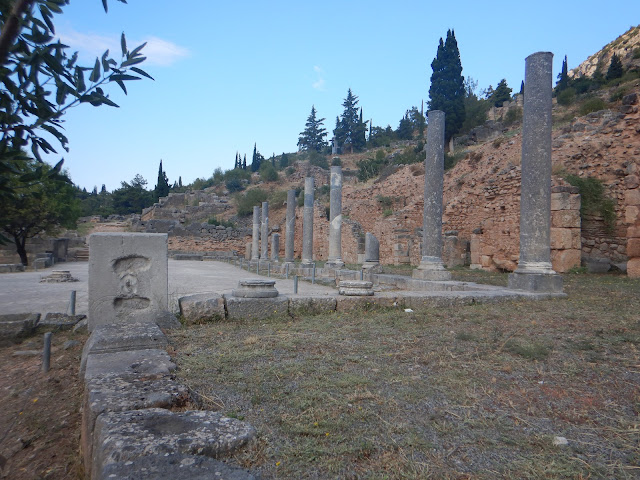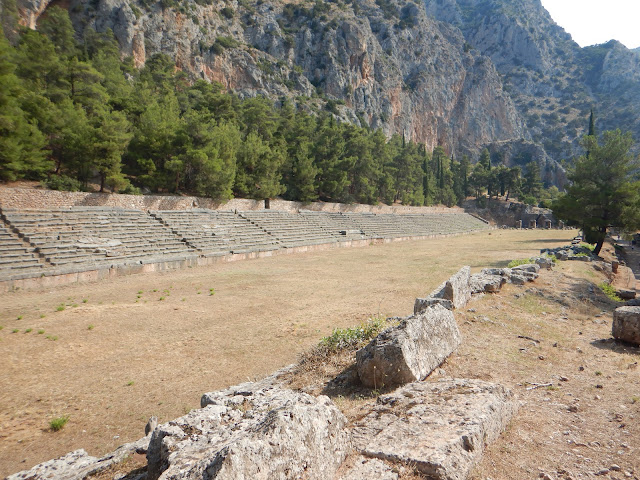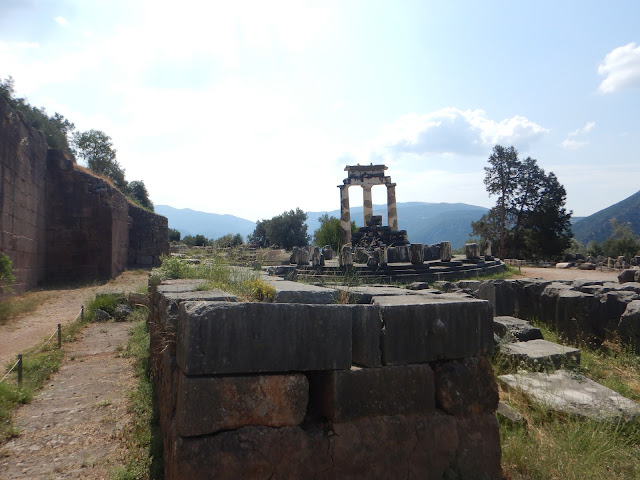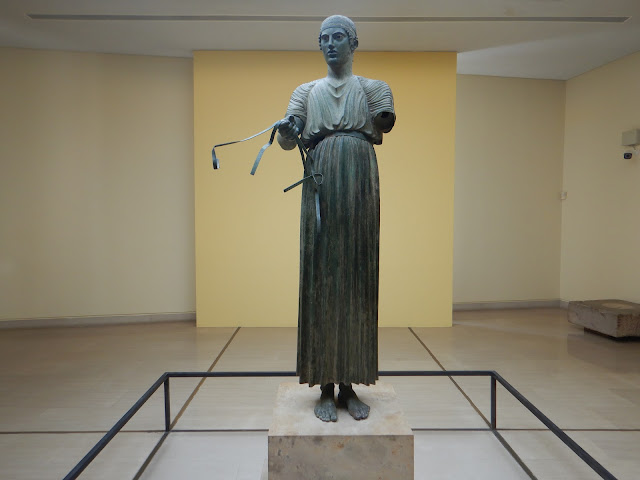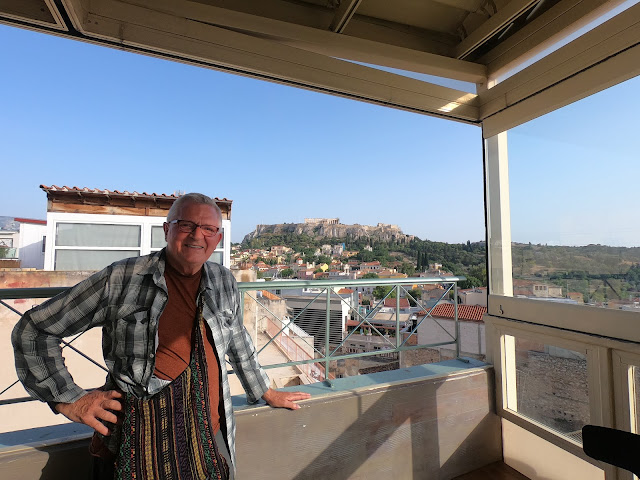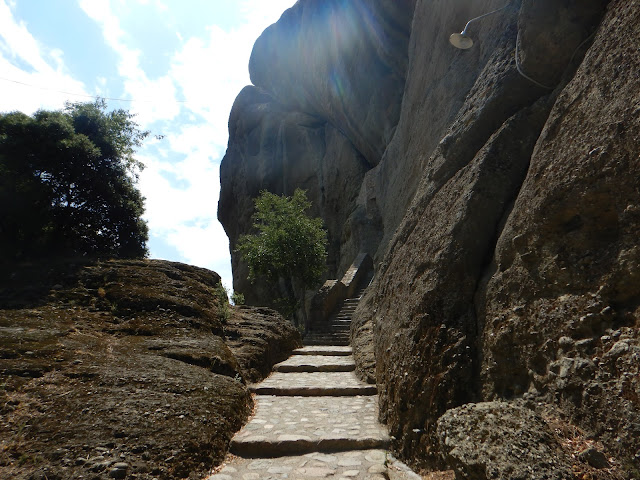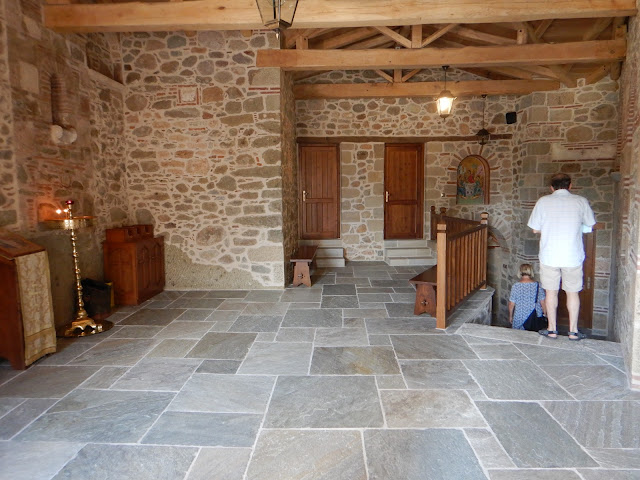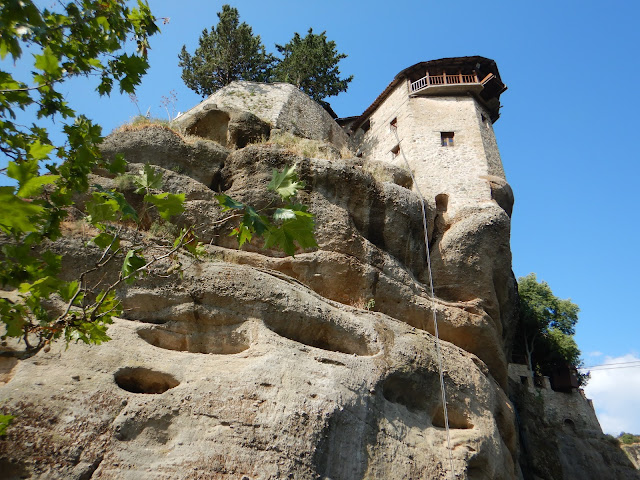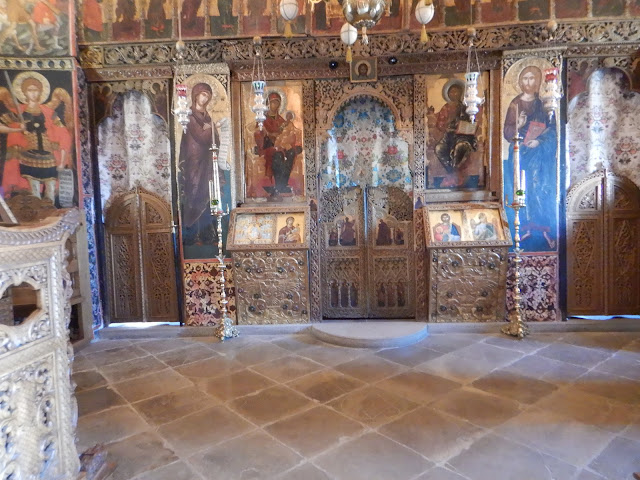View of Ancient Delphi from above the Theater.
I began my day by finding a cafe that opened early so I could have breakfast before my long bus journey to Delphi. The bus left at 9am and when I booked it, I thought it was a non-stop bus to another popular tourist area. I was wrong.
I ended up changing buses 4 times with waits of 15 minutes to an hour at each stop. At each stop, I thought it would be the last transfer. It was a 21km ride to Trikala, a 117km ride to Lamia, a 72km ride to Amfissa, and finally a 20 km ride to Delphi which took 6 hours. At Lamia, we stopped for an hour and I bought one of those greasy spinach and cheese pastries at a to-go counter and washed it down with peach juice. Because of the COVID restrictions or the drop in travelers, the restaurants at the bus station were all closed.
It was a beautiful journey through the mountains—many tunnels—on some very windy hairpin roads along with some narrow one-lane country roads.
The small town of Delphi is perched on the edge of the mountain with some spectacular views of the olive orchards flowing down to the Gulf of Corinth and the town of Kirra.
I checked into the Epic Rooms Hotel which was my second hotel during these travels and it was clean and simple and most importantly had A/C in this 90 plus weather this time of year. I had earlier booked the Hotel Sibylla as recommended by the Lonely Planet guide, and when I got the non-refundable confirmation from them that it was a fan-only room, I sent them an email asking for an upgrade to an A/C room. Apparently, they did not have A/C, but they instead canceled my reservation which was a welcome surprise and a big relief.
It was late in the day, so I planned to get to the Ancient Delphi site and museum when they opened at 8am. I decided to visit the museum after I toured the site when it was hotter and I could enjoy the coolness of an A/C museum. I was curious to see where the fabled Oracle of Delphi had provided pilgrims prophecies for over 1,000 years that peaked between the 6th and 4 centuries. Maybe I might get an answer to my question, “Will I continue to travel a lot?”
Fortunately, the day started off cool with some clouds as I entered Ancient Delphi. With a 12 Euro admission fee, it covered both the site and the museum. I first came to the Roman Market along the Sacred Way. Pilgrims would arrive here after they purified themselves at the Castalia Springs and making an offering.
Early on during the Mycenaean times—14th-15th BC—the early deity was “Ge”—Mother Earth. Much like other early civilizations and even among the Quechua in South America, Mother Earth is revered and called Pachamama. Even modern-day Peruvian spill a bit of their drinks on the ground to honor Pachamama.
The honoring of Apollo began here after he had slain a she-dragon in a cave in the nearby Mt. Parnassos between the 11th to the 9th BC centuries. By 7th BC, the cult of Apollo and Athena began to be established. Many city-states built treasuries here to honor Apollo. Here is the only reconstructed one of the city-state of Athens.
By then the oracle was well established after first issuing prophecies at the Rock of Sibyl.
After the Temple of Apollo was built, the oracle issued prophecies from there. The wall surrounding this temple was formed using tightly mitered polygonal stones which reminded me of the Inca walls found in Cusco, Peru.
When pilgrims arrived, they first went to the Castilia Springs for purification and paying tribute before entering Ancient Delphi up the Sacred Way.
Along the Sacred Way to the Temple of Apollo, the pilgrims would find a Roman Market, various statutes honoring past wars and victories, and the city-state treasuries. The Athenian Treasury has been partially restored and is near the omphalos.
The omphalos symbolized that Delphi was the center of the world.
I next came to the Rock of the Sibyl and listened for the oracle to answer my earlier question and it was “It depends on you.” Some of the comments about these prophecies are that they are vague and ambiguous. For example, Croesus of Lydia was told that he would destroy a grand empire if he invaded Persia, but the empire that was destroyed was his own.
The Stoa of the Athenians—covered walkway— remains are just in front of the polygonal wall.
The Temple of Apollo is just above the Stoa and is where the Oracle of Delphi relocated from the Rock of the Sibyl. Some of the columns have been restored.
As I continued up the Sacred Way and passing the Temple of Apollo, I came to the sanctuary theater where dramas, music, and dance performances occurred. In the museum, they have a 1930 picture of a performance there.
It was then about a 20-minute climb up to the Stadium where races were held along with other athletic events of the Pythian religious festival which was second only to the Olympics and occurred every 4 years.
I then walk downhill and out of Ancient Delphi and passed the Castalia Springs where pilgrims would purify themselves and make offerings before entering the Sacred Way.
I passed the Springs and the gymnasium below was a large area filled with various blocks of stone.
Further down the road was the Sanctuary of Athena Pronea which contains two temples honoring Athena and the Tholos temple which was built around 380 BC. Archeologists are not sure of the purpose of the Tholos temple which has been partially restored
It was then on to the museum where I enjoyed the A/C almost as much and the objects there. Many of the statutes and objects had been recovered from the Ancient Delphi site and were now protected from the elements.
The 11am bus to Athens was about a half-hour late and I was joined by Victoria from Paris, France at the bus stop. With her along in the bus driving down the twisty mountain road to Athens made the time go by quickly. She was a freelance music industry production manager who located and found locations and other items for the music video performances. Her recent gig was for a Croatian rapper who needed a grubby warehouse for part of his music video performance.
After getting dropped off at one of the KTEL bus stations, I found my way via the Metro to the Stafestay Hostel where I had first stayed when I arrived in Athens.
I leave at 7am on Lufthansa flights to Frankfurt and then on to Seattle with arrival at 12:30 pm and the same day—a very long day for me with a travel time of about 15 hours. I took the X95 bus to the airport since the Metro does not operate early enough. My next blog entries will post my travel costs for Croatia and Greece.
Subscribe to my YouTube Channel
I have recently uploaded all of my travel videos to YouTube now that they allow longer uploads. I have also added other shorter travel videos.
That link is https://www.youtube.com/c/huntforgold
If you do go there, please subscribe to my video channel since it will help me eventually get some income there and help with my future travels.




